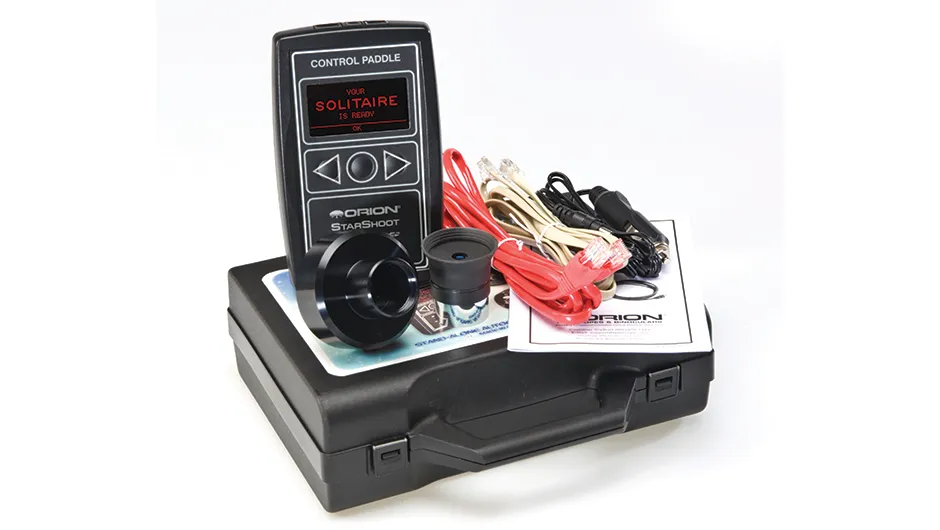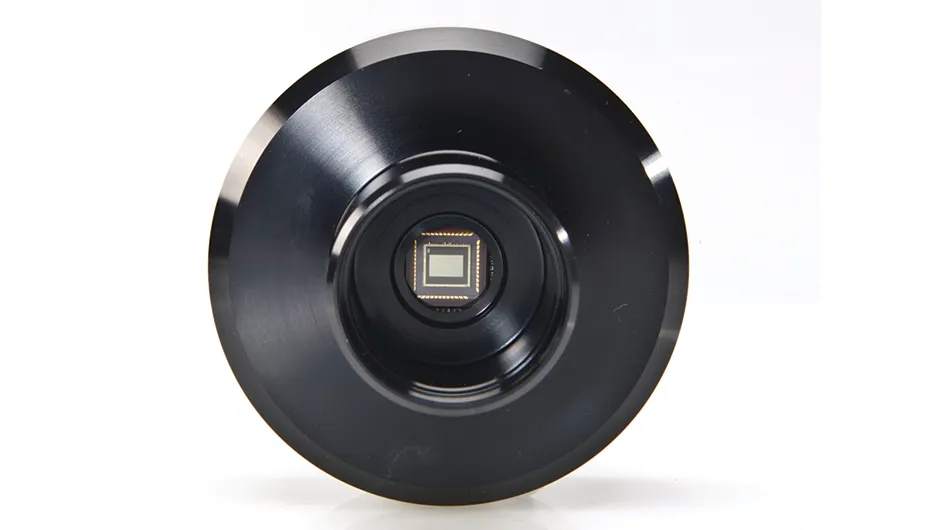The Orion StarShoot Solitaire is a stand-alone unit that will guide your mount without a PC; all you have to provide is a guiding telescope and a 12V DC power supply.
You should seriously consider using an autoguider if you plan to take pictures of the night sky.
These secondary digital cameras dramatically increase the tracking accuracy of your mount by detecting and automatically correcting errors in the mount’s movement as it follows the stars across the heavens.
This allows you to take clearer, sharper images and you can accurately track the stars for longer.
An autoguider does this by keeping tabs on a ‘guide star’ through a second telescope, usually fixed on top of the main scope.
The Solitaire has two parts: a small, lightweight digital camera, which is called the ‘guide head’, and a hand controller.The guide head fits in the scope’s focuser and connects to the controller with a 2.1m RJ45 cable.
The controller then connects to a Go-To mount with an ST4 cable, the industry-standard guiding connection that most Go-To mounts have.
There’s also a 3m power cord with a cigar lighter plug supplied.

No laptop required
The Solitaire does away with all the hassle that comes with operating a laptop with your imaging setup, but how does its performance compare to those PC-controlled models?
Its ability to track stars and keep your mount perfectly aligned is just as good as an autoguider that uses a laptop.
There’s just the tricky procedure of locating a guide star in the first place.
Whereas with a laptop you use the captured view on its screen to find and focus a guide star, the Solitaire’s display doesn’t actually show the star field itself.
Instead, you use an eyepiece to locate, centre and focus a suitable guide star and then replace the eyepiece with the guide head to start autoguiding.
This procedure works well, but isn’t as convenient as selecting a guide star on-screen.
In use, the Solitaire shows a constantly updated graph of Right Ascension and Declination errors to keep you informed of the guiding accuracy.
By smoothing the graph’s peaks and troughs, you can fine-tune the tracking.
The hand controller’s clear red graphical display screen gives access to all of its control functions, although it doesn’t show you an image of the actual guide star.
Instead, you use a supplied 9mm eyepiece to find, centre and focus a suitable guide star.
The eyepiece has the same focus position as the guide head – it’s ‘parfocal’ – to ensure that when the star is in focus through the eyepiece, it’ll be correctly focused in the guide head too.
Once you’ve focused on a guide star you replace the eyepiece with the guide head and choose the ‘focus’ option on the controller.
The system now automatically scans the whole image frame looking for the guide star and rewards you with a ‘Star Found! …Adjusting Exposure’ message.
Although this procedure works quite well, it’s not as easy as using the real view display you get on a laptop with autoguiding software.
We found it rather awkward – especially as Orion recommends a straight-through view for the eyepiece, which makes looking through it more difficult than using a star diagonal.
With the star found, the screen then changes to show a small rectangle with a ‘+’ sign in it, indicating the star’s relative position in the frame.
Final focus adjustments can be made at this point (since the display doesn’t show the actual star, a sharper focus gets a lower focus value on the display), then ‘calibration’ is selected to determine the guide head’s orientation and work out which direction the guide star is moving in.
You then select ‘Start guiding’.

Shoot for the stars
The Solitaire’s sensor gave us a field of view of 38.8x24.8 arcminutes with the Sky-Watcher ST80 guidescope we used.
We mounted this refractor in adjustable tube rings so it could be pointed, if necessary, in a slightly different direction to the main scope.
This meant we could find a guide star without having to move the main imaging scope below it, thereby spoiling the framing of our images.
We found that the guiding accuracy depended very much on the guide star’s brightness: a dimmer star always resulted in poorer tracking accuracy.
Despite poor conditions, our images of NGC 7000 and the mag. +3.72 star Xi Cygni showed nice round star shapes, proving just how well the Solitaire works.
We were impressed by its performance under trying conditions, with clouds scudding by.
So, if you’re an astro imager and want to make the leap to autoguiding, but don’t want to lug a laptop around as well as your camera, the Solitaire is for you.
Vital stats
- Price£549.00
- SupplierThe Widescreen Centre
- Telephone0207 935 2580
- Websitewww.widescreen-centre.co.uk
This article appeared in the October 2009 issue of Sky at Night Magazine
